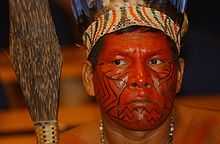Mura people
 | |
| Total population | |
|---|---|
| 5,540 | |
| Regions with significant populations | |
| Brazil | |
| Languages | |
| Mura |
The Muras are an indigenous people who live in the central and eastern parts of Amazonas, Brazil, along the Amazon river from the Madeira to the Purus. They played an important part in Brazilian history during colonial times and were known for their quiet determination and subsequent resistance to the encroaching Portuguese culture. Formerly a powerful people, they were defeated by their neighbors the Mundrucus in 1788.
Of the original diversity of Muran languages, only Pirahán survives today.
Historical Encounter with the Portuguese
According to Adélia Engrácia de Oliveira in Autos da devassa contra os índios Mura do Rio Madeira e nações do Rio Tocantins (1738-1739) (CEDEAM, 1986:1):[1][2] "It is known that they, who used their canoes as homes, nomadic indians ("Índios de Corso"), controlled a wide area of land from the border of Peru to River Trombetas, that they stood out for their great effort to repel the encroaching of the Portuguese, that they were valiant and fearless warriors, using special attack tactics, and that their incursions and raids frightened 18th century Amazonas."
The Mura were attacked by three successive and bloody "punitive expeditions", suffering many losses also due to epidemics like measles and smallpox. An inquiry was attempted against them, asking for "just war" around 1737 and 1738, but this was not granted. Under intense pressure, they sought a peace agreement in 1786, but never completely stopped their raids against the Portuguese. In 1835, they formed an alliance with the Cabanos, seeking to make Cabanagem an opportunity for the reconstruction of their lost freedom and of empowerment. According to Moreira Neto (1988), the culmination of the conflicts between the Mura and the regional society was its participation in Cabanagem alongside the rebels. He adds: "probably no other major indigenous group in the Amazon paid more dearly than the Mura in their fight against the continuous efforts to decimate and expel them from their traditional beaches and lakes".
From 1863, the Mura were no longer mentioned in official reports, but this doesn't mean that they were no longer involved in conflicts, as can be deduced from what the author further states: "a Mura subtribe, the Mura-pirarrã, which were considered in the nineteenth century the most secretive and aggressive Mura group, remains, even today, monolingual and isolated". The Mura are described as having never given up their resistance, but that it is simply now expressed by maintaining the language barrier between them and 'whites'".
Village Organization
Each village has a chief whose office is hereditary, but he has little power.
References
- ↑ Caldas, Yurgel Pantoja (Jan–June 2006). "Muhuraida: entre historia e ficçao" [Muhuraida: between history and fiction]. Nau Literária. Revista eletrônica de critica e teoria de literaturas (in Portuguese) 02 (01): 1.
- ↑ "Indigenous peoples: Mura (translated)". Brazilian Minister of Justice, Indigenous Peoples (in Portuguese). © 2007 Ministério da Justiça. 2007. Retrieved 21 March 2011.
![]() This article incorporates text from a publication now in the public domain: Chisholm, Hugh, ed. (1911). Encyclopædia Britannica (11th ed.). Cambridge University Press
This article incorporates text from a publication now in the public domain: Chisholm, Hugh, ed. (1911). Encyclopædia Britannica (11th ed.). Cambridge University Press